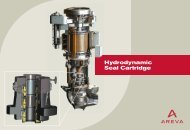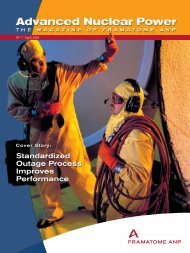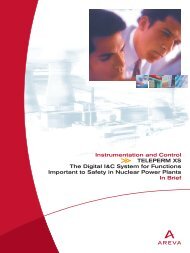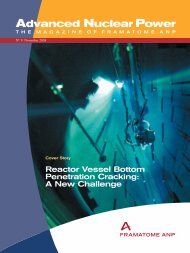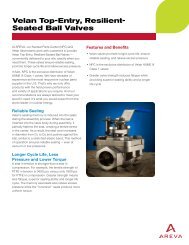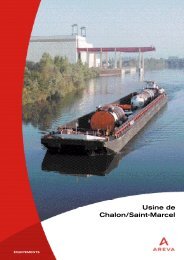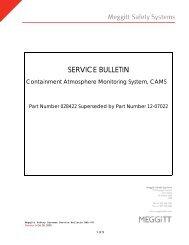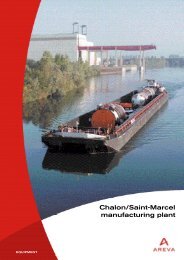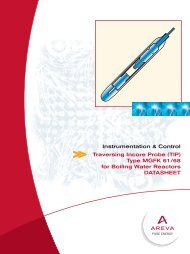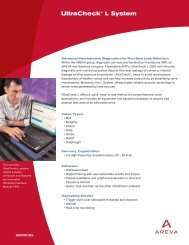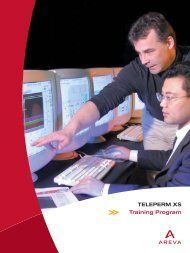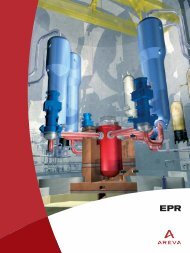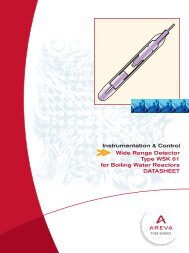Areva EPR
Areva EPR
Areva EPR
You also want an ePaper? Increase the reach of your titles
YUMPU automatically turns print PDFs into web optimized ePapers that Google loves.
■ <strong>EPR</strong> NUCLEAR ISLAND<br />
INSTRUMENTATION & CONTROL SYSTEM<br />
A nuclear power plant, like any other industrial facility, needs technical means to monitor and control its<br />
processes and equipment. These means, as a whole, constitute the plant Instrumentation & Control (I & C)<br />
processes, which actually comprises several systems and their electrical and electronic equipment.<br />
Basically, the I & C system is composed of sensors to transform<br />
physical data into electrical signals, programmable controllers<br />
to process these signals and control actuators, monitoring and<br />
control means at the disposal of the operators.<br />
The overall design of the I & C system and associated equipment<br />
has to comply with requirements imposed by the process, nuclear<br />
safety and operating conditions.<br />
To design the <strong>EPR</strong> and its I & C system, specific attention has been<br />
given to ensure a high level of operational flexibility in order to fit with<br />
electricity companies’ needs. As a result, the <strong>EPR</strong> is particularly well<br />
adapted to load follow and remote control operation modes.<br />
† A plant I & C system, completely<br />
computerized, supported by<br />
the most modern digital technologies,<br />
for high-level operational flexibility<br />
<strong>EPR</strong> I & C OVERALL ARCHITECTURE<br />
Inside the overall I & C architecture, each system is characterized<br />
depending on its functions (measurement, actuation, automation,<br />
man-machine interface) and its role in safety or operation of the plant.<br />
A several level structure<br />
Consideration of the different roles played by the different I & C<br />
systems leads to a several level structure for I & C architecture:<br />
• level 0: process interface,<br />
• level 1: system automation,<br />
• level 2: process supervision and control.<br />
(A level 3 deals with site management functions).<br />
Different general requirements are assigned to each level.<br />
The “process interface” (level 0) comprises the sensors, and the<br />
switchgears.<br />
The “system automation” level (level 1) encompasses I & C systems<br />
to perform:<br />
•reactor protection,<br />
• reactor control, surveillance and limitation functions,<br />
•safety automation,<br />
• process automation.<br />
The “process supervision and control” (level 2) consists of:<br />
• the workstations and panels located in the Main Control Room,<br />
the Remote Shutdown Station and the Technical Support Centre,<br />
which are also called the Man-Machine Interface (MMI),<br />
• the I & C systems which act as link between the MMI and the<br />
“system automation” level.<br />
Safety classification<br />
I&C functions and equipment are categorized into classes in<br />
accordance with their importance to safety. Depending on their<br />
safety class, I & C functions must be implemented using equipment<br />
having the appropriate quality level.<br />
Redundancy, division, diversity and reliability<br />
I&C systems and equipment of the <strong>EPR</strong> comply with the principles<br />
of redundancy, division and diversity enforced for designing <strong>EPR</strong><br />
safety-related systems. As an illustration, the Safety Injection System<br />
and the Emergency Feedwater System, which consist of four<br />
redundant and independent trains, have four redundant and<br />
independent I & C channels.<br />
Each safety-related I & C system is designed to satisfactorily fulfil its<br />
functions even if one of its channels is not available due to a failure<br />
and if, at the same time, another of its channels is not available for<br />
preventive maintenance reasons or due to an internal hazard (e.g.<br />
fire).<br />
I&C systems and equipment participating in safety functions are<br />
specified with a level of availability in compliance with the safety<br />
probabilistic targets adopted to design the <strong>EPR</strong>.<br />
† A quadruple redundant safety-related I & C<br />
for a further increased level of safety.<br />
Description of the I & C architecture<br />
Functional<br />
safety class<br />
Equipment<br />
quality level<br />
F1A Functions required in case of accident E1A<br />
to bring the reactor to controlled state.<br />
F1B Functions required after an accident to bring E1B<br />
the reactor to safe state.<br />
Functions intended to avoid the risk<br />
of radioactive releases.<br />
F2 Other functions contributing to plant safety E2<br />
(adherence to limit operating conditions,<br />
surveillance of safety system availability,<br />
protection against the effects of internallygenerated<br />
hazards, detection/monitoring<br />
of radioactive releases, functions used<br />
in post-accident operation…).<br />
NC Non-classified functions. NC<br />
I&C technology<br />
Concerning I & C technology, Framatome ANP uses a consistent<br />
I&C system based on its TELEPERM-XS technology for safety<br />
applications and on a diversified technology for standard applications.<br />
40 I



